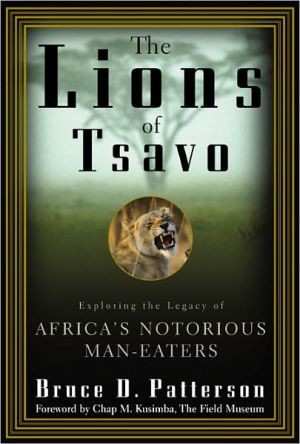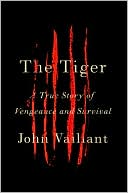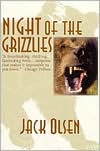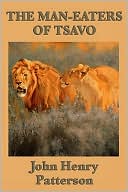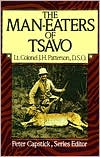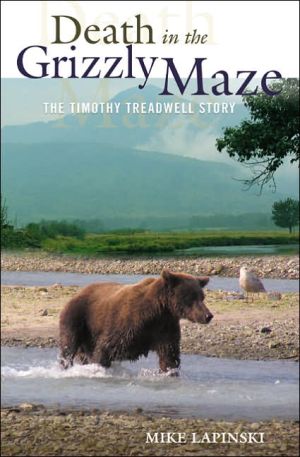The Lions of Tsavo: Exploring the Legacy of Africa's Notorious Man-Eaters
"Deftly written . . . Patterson's book must now be considered the definitive Tsavo lion study... one of the world's leading experts on lions as well as an important conservationist."—Publishers Weekly\ Through field research and forensic evidence, a scientist reveals his theory on why two Kenyan lions killed humans and then ate their prey\ In March 1898, the British began building a bridge over the Tsavo River in East Africa. In nine months, two male lions killed and ate nearly 135 workers,...
Search in google:
"Deftly written . . . Patterson's book must now be considered the definitive Tsavo lion study. Patterson's research at Chicago's Field Museum and Tsavo National Park—the most important wildlife preserve in East Africa—have established him as one of the world's leading experts on lions as well as an important conservationist."—Publishers Weekly"It was a great relief to find this wonderfully thorough, scientific, and hugely accurate tome . . . the thrill of so many new details (and newly found photos) put together in historical (Darwinian) biological and ecological perspective. Not a stone is left unturned in this cunning cat and mouse game (on a big scale) where the hunter is the hunted and the jungle beast appears like a ghost at night to kill."—Peter Beard, Photographer, Naturalist, and Author of The End of the Game"Through tenacious research and in elegant words, Bruce Patterson has demystified one of Africa's most celebrated tales of derring-do. Thanks to the spirited curiosity of this 21st Century researcher and his team, history can, at last, be told, and the lion can take its place, in a fashion, as king of the beasts. Even man-eaters, we may conclude, are worthy of our admiration."—John Heminway, filmmaker, producer, and Author of Yonder: A Place in Montana"The man-eating lions of Tsavo are but two of more than 22 million specimens in the Field Museum's collections. Each has stories to tell. Like the Tsavo lions, each can speak to evolutionary origins, growth and development, ecology, functional morphology, and behavior. Patterson's account criss-crosses these now-disparate fields, recalling a time when all were unified as 'natural history."'—John W. McCarter, Jr., President and CEO, The Field MuseumA little over a century ago, at the height of European colonial expansion in Africa, the British undertook to "tame the wilderness" with a trans-Kenya railroad from Mombasa on the Indian Ocean to Lake Victoria. One hundred and thirty miles in, at what is now the Tsavo National Park, one of the world's largest wildlife preserves, nature struck back in the form of two male lions, which began to systematically hunt, kill, and devour railroad workers. The rampage lasted for more than nine months and is thought to have claimed the lives of 135 people. More lives would have been lost if not for Colonel John H. Patterson, a civil engineer tasked with building a bridge across the Tsavo River who, after an arduous 9-month hunt, killed the lions, earning the title of "liberator" among his crews and international acclaim as a sportsman.The story of the Tsavo man-eaters has captivated the public's imagination for more than a century while giving rise to considerable scientific debate. What compelled those lions to prey on human beings—was it a matter of necessity, self-defense, or simply one of opportunity? And why are the lions indigenous to this region maneless? Is there something about maneless lions that makes them especially prone to becoming man-eaters, or is human predation by lions more common than we have been led to believe? What can the events of 1898 teach us about the extraordinary Tsavo lions and about lions in general?In an effort to answer these questions, Bruce Patterson, principal investigator of the Tsavo Research Program and curator at the Field Museum, where the Tsavo man-eaters are on exhibit, has conducted extensive field research throughout the region. Now, in The Lions of Tsavo, he shares his findings. Working from original accounts, he retells the harrowing story of those bloody nights in Kenya. In a balanced discussion of competing alternatives, he presents forensic evidence that the man-eating behavior exhibited in 1898 was likely due to pathology, but argues that most man-eaters and stock-raiders today result from human encroachment on wild habitats.In attempting to solve the century-old mystery of the Tsavo rampages, Patterson goes beyond the "Reign of Terror" of 1898 to offer a fascinating natural history of Panthera leo. A leading expert on lions and their ecology, he shares much about the evolutionary biology, anatomy and physiology, social behavior, mating patterns, and hunting strategies of the king of predators. And in the process, he comes to the somewhat disconcerting conclusion that, for lions, once they have tasted human flesh, "man-eating very quickly becomes a habit, a routine, a way-of-life."Bruce D. Patterson, PhD, is the MacArthur Curator of Mammals at the Field Museum of Natural History in Chicago, home to the lions killed by Colonel Patterson in 1898. He also teaches at the University of Chicago and the University of Illinois, is President of the American Society of Mammalogists, and a PI of Earthwatch Institute's "Lions of Tsavo" project.
ForewordIntroduction : a confluence at Tsavo1Ch. 1The reign of terror : the lions of Tsavo attack11Ch. 2The terror continues : man-eating lions today39Ch. 3Killing behavior and man-eating habits49Ch. 4Why do lions kill people?63Ch. 5Lion biology : evolution and geographic distribution99Ch. 6Hunting and social behavior121Ch. 7The lion's mane : geographic and individual variation139Ch. 8Why the lions of Tsavo are maneless157Ch. 9Conservation and Tsavo national parks183
